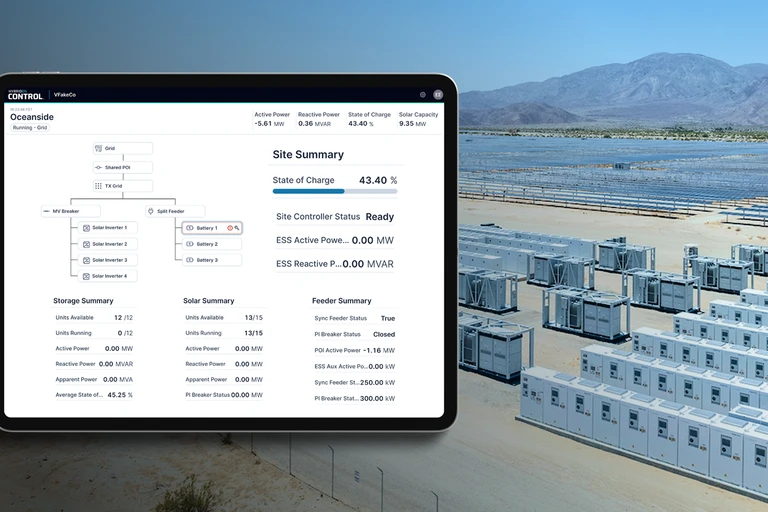Co-locating energy generation with battery storage has become more prevalent in the U.S. due to clear advantages to project developers, energy operators, and the grid. For developers, a hybrid project requires a single interconnection point, enables cost-sharing, and increases system efficiency. For utilities, pairing traditional energy sources and renewables with battery storage helps smooth out variable loads and maximize resource utilization, making for a more stable and resilient grid. This is increasingly important as the country shifts from relying primarily on consistent, centralized thermal generation to include a larger mix of intermittent renewable sources. And, hybrid power plants are essential to meet energy needs for data centers, including power reliability, flexibility, and compliance.
Though there are clear benefits, hybrid power plants introduce a level of complexity across the entire project lifecycle, from design and contracting to integration and operation. Fortunately, turnkey solutions exist to simplify project development and management while maximizing asset value. In this article, we’ll look specifically at simplifying and optimizing hybrid site operations and controls.
Co-locating energy generation and battery storage does not mean operators have to manage individual resources and site-level controls with fragmented systems, which can add risk, create operational friction, and erode margins. Instead, with integrated controls, or a master plant controller (MPC), operators can better maximize their project’s generation and value. In today’s evolving energy market, every kilowatt counts, and a project’s controls and monitoring software can determine whether it hits revenue, performance, and reliability targets.
Within the hybrid space, solar-plus-storage is booming
Though battery storage pairs with all forms of generation, solar-plus-storage sites are the clear frontrunner in terms of installed and planned capacity in the U.S., largely due to their speed to market and levelized cost of energy. In the first half of 2025, solar and battery storage represented roughly 76% of all new capacity in the U.S., with developers adding 12 GW of utility-scale solar and 5.9 GW of storage. Hybrid solar-plus-storage projects represent about 22% (571 GW) of all capacity in U.S. transmission interconnection queues.
While co-locating generation and storage makes projects more complex, integrated solutions exist to help simplify and streamline projects from planning and design, through commissioning and long-term maintenance. Overall, the performance and financial benefits of hybrid solar-plus-storage power plants outweigh the challenges, which is why we’re seeing such a big boom.
Capacity in interconnection queues as of the end of 2024. Source: Berkeley Lab
By pairing solar with storage, a power plant can maintain a consistent capacity profile and deliver firm output, even as solar panels naturally degrade over time—typically less than 1% per year. Battery storage systems help smooth out solar generation by charging when there is abundant supply and discharging during peak demand. This load-shifting strategy is particularly valuable in markets like CAISO and ERCOT where the grid experiences a “duck curve,” as solar power drops off before demand spikes after sunset. By reducing curtailments of excess solar power and helping to avoid wasted low-cost electricity, battery storage maximizes the value of solar investments.
Even if storage isn’t built on day one, most solar developers are planning for it because of the potential to boost project revenue by 29% to 81% in certain markets.
Preparing for a hybrid future with integrated control
Traditionally, solar-plus-storage project operators have used separate power plant controllers (PPCs) for each technology, plus a third-party SCADA system. The challenge with this configuration is that it can bring greater risk with more points of failure, integration delays that extend time to revenue, and operational silos that slow down decision-making.
To help eliminate those pain points, and streamline power plant controls, FlexGen provides a central orchestration layer for various energy assets and configurations through its energy management software. FlexGen’s HybridOS® Solar Power Plant Controller is an MPC for solar generation and battery storage that allows users to leverage HybridOS to control solar assets and their components, like solar arrays, trackers, MET stations, and capacitor banks.
FlexGen’s HybridOS® Solar Power Plant Controller can integrate solar and battery energy storage control in a single platform, or function independently as a dedicated solar PPC.
For solar-only operators, an MPC future-proofs solar plants, so they’re set up to seamlessly become solar-plus-storage hybrids without needing to rip out any infrastructure. For hybrid project operators, integrated control supports greater efficiency, uptime, and performance.
Efficiency: Less complexity and fewer integration risks
Managing solar and storage through a single platform cuts out the cost, complexity, and delays of juggling multiple control systems. Operators can co-optimize assets in one interface, making it easier to adjust site strategies and maximize revenue.
Uptime: Streamlined start-up and minimized downtime
A unified solar-plus-storage controller also helps reduce execution timelines by deploying pre-tested and pre-configured control logic for hybrid sites. And with integrated alarms, fault detection, and coordinated response, an MPC can maximize a hybrid power plant’s uptime and availability.
Performance: Maximized generation and grid support
When used as a hybrid controller for solar and storage, HybridOS enables operators to capture and shift curtailed solar energy into the evening hours, turning lost production into critical grid support during peak demand. With its advanced control modes, HybridOS also optimizes solar-plus-storage dispatch, voltage regulation, and real-time or day-ahead capacity forecasts.
Without storage on site, HybridOS still maximizes solar generation and supports grid stability, even as solar efficiency naturally declines over time.
Building smarter, more reliable solar and hybrid power plants
While PPCs used to be viewed as a compliance checkbox, they’ve evolved into a competitive advantage and strategic tool for the growing number of hybrid project developers and operators. Master plant controllers that integrate generation and storage controls can help operators maximize output and value, reduce downtime, and better support the grid with reliable, efficient power.
As developers plan for future projects, investing in smarter, unified controls today will create a smoother path to hybrid integration tomorrow. Learn more about integrating your solar and storage control with HybridOS Solar PPC.




